Every
-
- Ohmsett: Advancing Spill Response Every Day Marine News, Oct 2016 #20
The National Oil Spill Response Research and Renewable Energy Test Facility has been an integral part of the spill response community for more than three and a half decades.
Tucked away on the shores of the Sandy Hook Bay in central New Jersey resides Ohmsett – The National Oil Spill Response Research and Renewable Energy Test Facility. It has been an integral part of the spill response community for more than three and a half decades. Government agencies, private industry, and oil spill response organizations from around the world have visited the facility for testing, research and training.From booms, skimmers and dispersants, to cold water testing and Remotely Operated Vehicle evaluations, Ohmsett has assisted researchers and manufacturers in evaluating cutting edge technologies that are helping remove spilled oil from the worlds’ oceans.Managed by the U.S. Department of Interior’s Bureau of Safety and Environmental Enforcement (BSEE) and operated through a contract with MAR (MD) LLC, Ohmsett is part of the Bureau’s oil spill research program. Ohmsett directly supports BSEE’s mission to ensure the best and safest oil spill detection, containment and removal technologies are available to protect the U.S. coastal and ocean environments.
Realistic Testing in World Class FacilitiesAt the heart of the facility is one of the largest outdoor saltwater wave/tow tank facilities in North America. It is the only facility where full-scale oil spill response equipment testing, research, and training can be conducted in a marine environment with oil under controlled environmental conditions.The tank measures 203 meters long by 20 meters wide by 2.4 meters deep and is filled with 10 million liters of crystal clear saltwater. The three movable bridges are capable of towing equipment up to six knots to simulate towing at sea. A crow’s nest mounted on the movable main bridge above the water provides a vantage point for mounting test equipment, such as sensors to remotely detect oil spills, as well as for video documentation of a test.The facility is also equipped with a computerized wave generator capable of producing wave characteristics of 59 cm height (H1/3 at 7 meter wavelengths), 83 cm height (H1/3 irregular waves), and wavelengths up to 30 meters.Ohmsett plays a critical role in providing full-scale evaluations of equipment and remediation techniques that enable rapid and efficient response to an actual spill. “We are the intermediate step between small-scale bench testing and open water testing,” says Paul Meyer, BSEE’s Ohmsett Manager. “With the ability to control the testing environment, we are able to provide repeatable test conditions. This way, any equipment modifications can be measured and compared with each test performed, giving our customers the opportunity to optimize equipment performance.”With a wide range of testing and research capabilities, the oil spill response community relies on Ohmsett for independent and objective testing. “Our staff of engineers and technicians assists customers with test protocol development, product evaluations, and provides improvement recommendations,” says John Delia, MAR program manager for Ohmsett.The Nuts & Bolts of Research & TestingOver the years BSEE has funded multiple research projects at Ohmsett. Most recently, two highly successful projects conducted by BSEE were the Diminishing Slick Thickness test and the ICEHORSE Submersible Skimmer. Earlier this year, Ohmsett personnel conducted performance testing of two oleophilic skimming systems to better understand the relationship between Oil Recovery Rates and Recovery Efficiencies in varying oil slick thicknesses or diminishing slick thicknesses.At Ohmsett, skimming systems are tested to the ASTM F2709, the standard for testing the performance of stationary skimmers in calm water conditions. However, the ASTM F2709 standard calls for testing in 3-2 inches of oil in order to create the ideal conditions necessary to measure a skimming system’s maximum performance. But, in an actual oil spill it is likely that a skimmer will operate in a thinner range of oil thicknesses. In this test series, a drum and disc skimmer were tested to ASTM F2709, as well as in various other oil slick thicknesses ranging from 2-inches to 1/8-inch using standard refined test oil.“This series of experiments was the first of its kind and represents a continuation of basic research data associated with quantifying skimmer performance with varying test parameters,” stated Kristi McKinney, a BSEE project manager.A significant oil spill response challenge is recovering oil in ice. While response equipment and techniques to contain and recover oil spills in the offshore Arctic regions already exist, there remains a testing and evaluation requirement to determine how well they perform, and to help improve them for use in cold water and ice environments. As such, BSEE has dedicated resources to advance the knowledge of oil spill response capabilities in cold water and ice-infested environments.“During the winter months, we can replicate cold climate conditions at Ohmsett by using a chilling system to regulate the water temperature in the test basin,” stated Mr. Delia. “In addition, we place manufactured sea ice in the test tank to simulate an ice field in which response equipment will be operating.”The sea ice is sourced from the U.S. Army’s Corps of Engineers Cold Regions Research and Engineering Laboratory (CRREL) where it is manufactured or “grown” to support multiple Army research programs for extreme climates. Recently, however, Ohmsett staff engineers designed and developed a system for producing the ice blocks on-site. Frames were constructed at the facility, and chiller boxes maintained at 0o F were used for freezing and storage.Using this new on-site capability for testing in a simulated Arctic environment, the staff created ice for a BSEE funded project to develop a new approach to how oil skimmer technologies are deployed in ice-infested waters. It is anticipated that the technology could potentially improve the response industry’s ability to remove oil from otherwise inaccessible locations.In 2014, Alion Science and Technologies of New London, Connecticut was tasked with developing a submersible skimming system that can be deployed from a vessel and maneuvered underwater to the location of the oil. In February 2016, the prototype system was tested in an oil and ice field at Ohmsett. The prototype, called the ICEHORSE, consists of a small smoothed drum skimmer and three ROVs mounted to an aluminum frame, with an ice cage to prevent ice from interfering with the oil recovery process.The ICEHORSE was assessed on its ability to maneuver, travel speed, thrust, turning radius, and submerging and surfacing characteristics. After those initial tests, ice and diesel fuel oil (dyed red for visibility) were placed in a boomed test area to create a spill within broken ice. The skimmer system, initially located outside the test area, submerged, traveled underwater, and surfaced among the oil and ice to recover the oil.“The submersible skimmer test successfully demonstrated the concept of operation. The prototype was able to successfully submerge, maneuver under the ice, surface within the field and recover diesel oil,” commented Ms. McKinney. “Next steps will be to review test results with an eye towards future development of this concept.”BSEE Invests so that Industry can SucceedFor 35 years, Ohmsett has moved the ball forward in all aspects of spill response testing and researchWith the new advances in technology for responding in ice conditions, BSEE has invested in the facility with newly developed equipment to measure oil slick thickness and ice coverage during testing. An acoustic tool adapted to operate from a ROV, detects oil in and under ice, tracks location, and measures thickness. The sensors provide real-time measurements of the slick thickness and include cameras for real-time viewing and recording.To accurately and rapidly assess cold water and ice testing parameters such as total surface oil versus ice area coverage and oil layer thickness, a thermal imaging camera with processing software was developed specifically for use at Ohmsett. The Tactical Rapid Airborne Classification System (TRACS) creates images that separate ice, water and oil of several thicknesses based on differences in the thermal emittance.
The AuthorJane-Ellen Delgado is the Senior Marketing Communications Specialist of the Ohmsett Facility. She has been with Ohmsett since 2004 managing the branding of the facility. Ms. Delgado holds an MBA in Marketing from the City University of Seattle, WA and a B.S. in Journalism from the State University of New York at Brockport. On the WEB: www.ohmsett.com(As published in the October 2016 edition of Marine News) -
- Forrest Lucas: The 'Every Man' Tycoon Maritime Reporter, Nov 2016 #24
to build a corporate empire. From truck driver to truck fleet owner to oil and media magnate – including naming rights to an NFL stadium – Lucas is the ‘every man’ tycoon with eyes on the commercial maritime market. Talk to Forrest Lucas for five minutes and it is easy to see that his claims to be a ‘regular
-
- Robert Allan: Naval Architecture is in the Blood Maritime Reporter, May 2003 #50
Shakespeare. MR/EN recently spoke with Robert G Allan, who since 1982 has held the position of president of his grandfather's firm. He discusses everything from the beginning of his firm, to the recent delivery of a spectacular fireboat for Los Angeles, to the future of vessel design. — Regina
-
- The (Updated) Responsible Carrier Program Marine News, Mar 2016 #18
by your fleet at large. Each vessel is required to be audited completely, utilizing all elements of the RCP vessel worksheet. These audits need to happen every 12 months, but unlike the ISM code, the anniversary of when the audit is required for each vessel can remain the same, provided the audit is completed
-
- Mariner’s Medical Certificates – the New Normal Marine News, Feb 2014 #22
or Merchant Mariner Credentials (MMC now) at least seven times at regular five-year intervals. And yet, the new requirement of medical certification every two years is intriguing. “Vessel owners/operators should ensure that all U.S. seafarers to which STCW applies hold a valid Merchant Mariner Credential
-
- Flexport & the Changing Face of Shipping Logistics Maritime Logistics Professional, Mar/Apr 2017 #12
provide, we’re helping our customers to ship more efficiently and allowing logistics managers to have full visibility and control into their shipments every step of the way.” Flexport was built from the ground up on a technology stack. Petersen says that the company is already far ahead of traditional
-
- Performance-Based Assessments Maritime Logistics Professional, Q3 2013 #44
largest privately held training facility in the country with over 125 approved programs and over 50,000 square feet of facilities, its clients come from every sector. As ample testament to the diversity and flexibility in its training programs, that client split, says Captain Ted Morley, MPT’s Chief Operations
-
- Condition Based Monitoring & Saving Cash Maritime Reporter, Oct 2014 #38
lines afloat, and that is best secured by running a lot of tight ships. And If you’re going to run a tight, compliant ship, it helps to monitor and track every turn of every piston, crank and wheel; every drop of fuel, ballast and waste; every change in the wind, current and speed, and a million things in
-
- Trimble Navigation Selects Tru-Chart Electronic Charts On CD-ROM Maritime Reporter, Nov 1991 #90
, according to Maptech's technical sales adminis- trator Henry Nicolle: "... they are true and faithful representations of the actual paper chart. Every detail of the cchart is preserved and displayed. That includes every depth contour, every depth sounding, buoy, wreck, coastal and land contour
-
- Shipbuilding: One-on-one with David M. Thomas, Jr. Maritime Reporter, Jan 2019 #30
the San Diego yard is compact and bustling with work, yet impeccably clean. Dave Thomas is passionate about safety, and he takes the health and welfare of every employee, colleague, client and guest personally. Most of all, Dave Thomas is passionate about everything U.S. Navy. Following a distinguished U.S
-
- AIS - Panacea or Pandora's Box Maritime Reporter, Jun 2003 #18
when functioning properly, it will provide the officer in charge of the navigational watch with a radar display that includes a mark for every significant ship within radio range, each with a velocity vector indicating speed and heading. Each ship 'mark' could reflect the actual size of
-
- Meet the Seastick Marine Technology, Jun 2015 #42
with a generous mix of experience and wisdom with some of the best up and coming bright minds. Nardini explains. “We are a team of mostly young people (everyone in the technical staff is under 30 years of age) that, combined with the experience of our CEO, who spent his whole life working in the submarine
-
 )
March 2024 - Marine Technology Reporter page: 27
)
March 2024 - Marine Technology Reporter page: 27suggests profound discoveries to come, featuring new technology. “Projects like TESMaP are literally rewriting our under- standing of volcanoes in every measure we look at,” said Mackay. Despite de- cades of research and new records broken, “there’s still so much more to uncover.” www.marinetechnologynews
-
 )
March 2024 - Marine Technology Reporter page: 19
)
March 2024 - Marine Technology Reporter page: 19long data-driven maintenance program based on Life time expectancy of the CP system in years (i.e. remaining highly accurate lifespan prediction for every CP anode pro- life of sacri? cial anodes), Recommended time to next inspec- tecting the entire subsea infrastructure. www.marinetechnologynews.com
-
 )
March 2024 - Marine Technology Reporter page: 18
)
March 2024 - Marine Technology Reporter page: 18compels operators to schedule CP inspec- of the signal peaks are interpreted as noise instead of being tions at predetermined intervals, typically every three to ? ve picked up as coating damage. years, or to conduct CP assessments opportunistically when In contrast, a new generation high sensitivity
-
 )
March 2024 - Marine Technology Reporter page: 17
)
March 2024 - Marine Technology Reporter page: 17electrode. cells are prone to drifting and necessitate regular recalibra- The CP level of structures can be measured with conven- tions — typically after every kilometer of pipeline surveyed, tional CP probes, provided that the structure is not buried or or every hour. www.marinetechnologynews.com 17 MTR
-
 )
April 2024 - Maritime Reporter and Engineering News page: 42
)
April 2024 - Maritime Reporter and Engineering News page: 42, it must also become unexpected way, compromising safety. over recent years, as a ‘stakeholder’ si- more ef? cient very quickly to meet the “In SOLAS, every ship system is con- multaneously mindful of the perspec- sustainability goals now set out for it. sidered independently, while the way to tives of
-
 )
April 2024 - Maritime Reporter and Engineering News page: 25
)
April 2024 - Maritime Reporter and Engineering News page: 25clogged; tion reports in the Paci? c and truckers could get access to Atlantic theaters talked about the ports. “logistics, logistics, logistics.” Every senior leader during that The MSC ? eet is aging. timeframe said it was absolute- How do you do all that ly a war of logistics. with old ships
-
 )
April 2024 - Maritime Reporter and Engineering News page: 13
)
April 2024 - Maritime Reporter and Engineering News page: 13most ef? cient approach Provide the smallest device that can do the job.3. today, but it holds the promise of eventually being carbon zero. Electrify everything.4. Don’t get me wrong, I am an ef? ciency freak, and I strongly Avoid building new carbon fuel IC equipment at all cost.5. support the inherent
-
 )
April 2024 - Maritime Reporter and Engineering News page: 10
)
April 2024 - Maritime Reporter and Engineering News page: 10. This feature is designed to im- prove the ef? ciency and effectiveness of inspections. A Phased Roll-out Core questions are mandatory for every inspection, irre- The roll-out of SIRE 2.0, which entered its third phase in spective of the vessel type, operations, or any speci? c voyage January
-
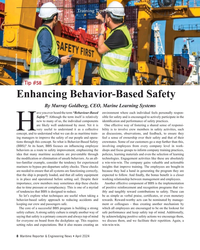 )
April 2024 - Maritime Reporter and Engineering News page: 8
)
April 2024 - Maritime Reporter and Engineering News page: 8Safety crewmates. Some of our customers go a step further than this, (BBS)? At its heart, BBS focuses on in? uencing employee involving employees from every company level in work- behaviors as a route to safety improvement, emphasizing the shops and focus groups to inform company training practices, idea
-
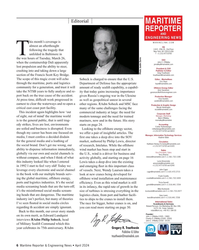 )
April 2024 - Maritime Reporter and Engineering News page: 6
)
April 2024 - Maritime Reporter and Engineering News page: 6.com +1.212.477.6700 ext 6240 in 1992 I start to feel very old! Today we and emerging ? eet in this important class John Cagni leverage every electronic and social channel of vessels. Next, Wendy Laursen takes a [email protected] | +1.631.472.2715 in the book with our multiple brands
-
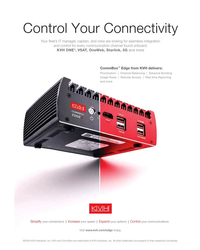 )
April 2024 - Maritime Reporter and Engineering News page: 5
)
April 2024 - Maritime Reporter and Engineering News page: 5Control Your Connectivity Your ?eet’s IT manager, captain, and crew are looking for seamless integration and control for every communication channel found onboard: ® KVH ONE , VSAT, OneWeb, Starlink, 5G and more ™ CommBox Edge from KVH delivers: Prioritization | Channel Balancing | Advance Bonding
-
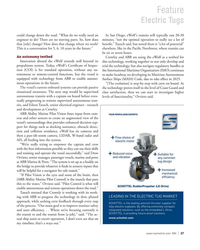 )
April 2024 - Marine News page: 37
)
April 2024 - Marine News page: 37stressed that Crowely is working with its work- ing with ABB to progress the technology in slow, phased approach, while seeking crew feedback through every step of the process. “Our main goal is to improve mariner safety and asset ef? ciency. . . Where we’re focusing currently is the transit to and
-
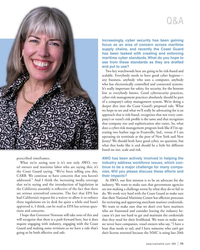 )
April 2024 - Marine News page: 11
)
April 2024 - Marine News page: 11. What do you hope to see from these standards as they are drafted and put to use? Two key watchwords here are going to be risk-based and scalable. Everybody needs to have good cyber hygiene— any business, anybody who uses a computer, anybody who has electronically controlled and connected systems.
-
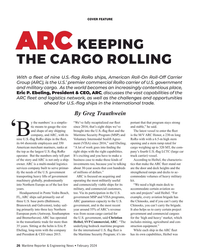 )
February 2024 - Maritime Reporter and Engineering News page: 26
)
February 2024 - Maritime Reporter and Engineering News page: 26. Via its participation in the U.S. sets and projects” said Heibel. “For FL, ARC ships sail primarily out of government MSP and VISA programs, example, every aviation brigade has three U.S. base ports (Baltimore, ARC guarantees capacity to the U.S. the Chinooks, and if you can’t carry the Brunswick and
-
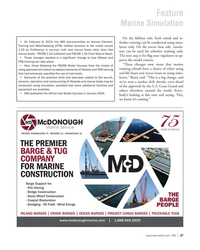 )
February 2024 - Marine News page: 37
)
February 2024 - Marine News page: 37, provided that some additional facilities and of the approvals by the U.S. Coast Guard and equipment are available. others elsewhere around the world. Every- • IMO published the of? cial new Model Courses in January 2024. body’s looking at this now and saying, ‘Hey, we know it’s coming.’” 37 www
-
 )
February 2024 - Marine News page: 36
)
February 2024 - Marine News page: 36a pivotal role in driv- needs to be replaced. “With our simulator, you can train ing regulatory change, particularly in advocating for the for that every day. Even the manufacturers of those systems use of simulators in maritime training. see the potential for this. So, I think that’s going to be an
-
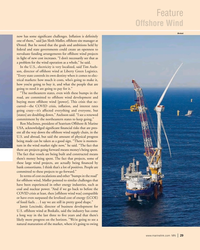 )
February 2024 - Marine News page: 29
)
February 2024 - Marine News page: 29operation as a whole,” he said. In the U.S., electricity is very localized, said Tim Axels- son, director of offshore wind at Liberty Green Logistics. “Every state controls its own destiny when it comes to elec- trical markets: how much it costs, who’s going to make it, how you’re going to buy it, and what
-
 )
February 2024 - Marine News page: 23
)
February 2024 - Marine News page: 23in August, “In honor of the 34 Conception victims and ecause there are so many different kinds of pas- senger vessels, the critical topic of passenger every other person who has lost their life on our nation’s waterways, I strongly encourage you to issue SMS regula- safety can sometimes appear as a set
-
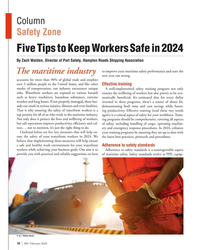 )
February 2024 - Marine News page: 18
)
February 2024 - Marine News page: 18the wellbeing of workers but also proves to be eco- such as heavy machinery, hazardous substances, extreme nomically bene? cial. It’s estimated that for every dollar weather and long hours. If not properly managed, these haz- invested in these programs, there’s a return of about $4, ards can result in serious
-
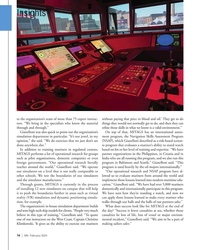 )
February 2024 - Marine News page: 14
)
February 2024 - Marine News page: 14We have seen how they’re standing a watch, and now we reality (VR) simulation and dynamic positioning simula- can apply those lessons learned to make every mariner who tion, for example. walks through our halls and the halls of our partners safer.” The organization’s in-house simulation department builds
-
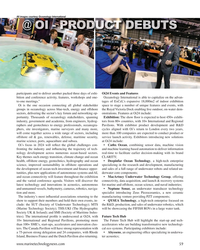 )
January 2024 - Marine Technology Reporter page: 59
)
January 2024 - Marine Technology Reporter page: 59. With exhibitor product development and R&D phers, site investigators, marine surveyors and many more, cycles aligned with Oi’s return to London every two years, will come together across a wide range of sectors, including more than 100 companies are expected to conduct product or offshore oil
-
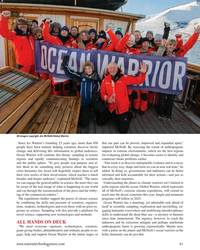 )
January 2024 - Marine Technology Reporter page: 41
)
January 2024 - Marine Technology Reporter page: 41real purpose and al- “Our remit is to discover indisputable evidence and to convey low them to do something truly positive about the biggest that in every way, shape and form we can in near real time,” he crisis humanity has faced will hopefully inspire them to tell added. In doing so, governments and
-
 )
January 2024 - Marine Technology Reporter page: 14
)
January 2024 - Marine Technology Reporter page: 14to Effective communication to all stakeholders is essential for suc- deep ocean, and extending from tropical seas to the cessful delivery. This covers everything from calibration expira- Tpolar ice edges. As operators of two global class re- tion of instruments, personnel capabilities, and budget manage- search
-
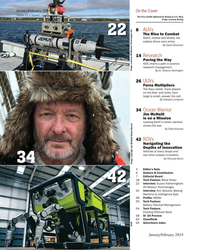 )
January 2024 - Marine Technology Reporter page: 2
)
January 2024 - Marine Technology Reporter page: 2McNeill is on a Mission Leading Earth’s citizen warriors across the sea. By Celia Konowe 42 ROVs Navigating the Depths of Innovation Vehicles of every shape and size drive subsea innovation. By Rhonda Moniz 34 Image copyright Jim McNeill/Global Warrior 4 Editor’s Note 6 Authors & Contributors 7
